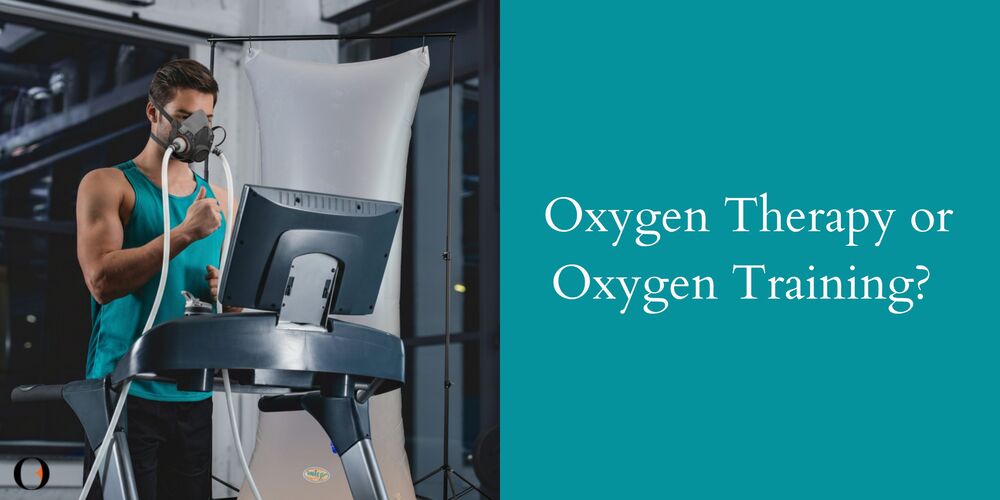Oxygen Therapy or Oxygen Training? Why the Answer Can Be Both
LISTEN TO THIS ARTICLE
We all breathe without a second thought, but oxygen is doing far more than just keeping us alive. It powers every cell in your body, aids in energy production, and plays a crucial role in recovery and performance.
Many of us think that supplemental oxygen can be used only for people with medical conditions or serious health challenges. And yes, that’s one side of the story. Oxygen therapy has long been widely used as a tool for supporting recovery and specific medical needs.
But there’s another side that’s often overlooked: oxygen isn’t just about treatment, it can also be about training. When combined with exercise, supplemental oxygen can amplify the benefits of physical activity and help you recover faster, perform better, and feel more energized.
When it comes to oxygen therapy vs. oxygen training, both have their place–one as a passive approach designed for rest and recovery, and the other as an active approach designed to push workouts and performance to the next level.
So the question is: should we think of it as oxygen therapy or oxygen training? The answer is–it can be both, depending on your goals, condition, and approach.
What is Oxygen Therapy?
Oxygen therapy is primarily designed to support people with health challenges. It is usually prescribed for individuals who:
- Cannot exercise due to medical limitations, or
- Need oxygen to help treat a specific health condition
Hyperbaric oxygen therapy is a well-known example of oxygen therapy. In HBOT, a person rests inside a hyperbaric chamber while oxygen is administered under pressure. HBOT is medically recognized to treat 14 specific conditions.
Let’s take a look at how hyperbaric oxygen therapy works. The mechanism behind HBOT is external pressure. Oxygen is diffused into the body proportional to the pressure inside the chamber.
Here are some key points:
- The process is passive, which means you lie inside the chamber, without movement.
- Chambers do not allow for exercise due to space constraints.
While HBOT is generally safe, there are some risks, such as:
- Lack of exertion may cause a CO2-O2 balance in extremely health-compromised individuals.
- Rapid pressure changes may cause discomfort or injury in the ears or lungs.
- Nitrogen dissolves into the blood under pressure. For this reason, people undergoing medical hyperbaric sessions are usually advised to avoid air travel for 24 hours afterward to reduce the risk of decompression sickness.
Rethinking Therapy
Therapy does not always mean inactivity. Combining oxygen with exercise can be therapeutic. Activities like walking on a treadmill while inhaling higher concentrations of oxygen can support recovery and overall wellness.
That’s the whole point of Exercise with Oxygen Therapy (EWOT).
What is Oxygen Training?
Exercise with Oxygen Therapy, or EWOT, can also be called oxygen training, because it uses supplemental oxygen to amplify the benefits of exercise, helping your body get more from every move. As you move, your body takes in extra oxygen, your blood flow improves, and your cells perform at their best. The exertion from physical activity activates the vascular system and maintains a healthy O2-CO2 balance.
Dr.Manfred von Ardenne studied oxygen training extensively and discovered a positive feedback loop in the endothelial cells of the capillaries. Left unchecked, this loop contributes to cardiovascular decline, especially from middle age onward. However, he showed that this decline is not fixed. With the right oxygen training protocols, this process can be reversed.
Benefits of Oxygen Training
Combining exercise with inhaling higher concentrations of of oxygen can help you:
- Optimize your strength training and take your fitness to the next level
- Accelerate your recovery
- Improve your concentration, tissue repair, and organ health
- Support your immune system, healing, and disease resistance
Most users notice improved energy, mental clarity, and performance within a week of starting oxygen training.
Therapy or Training? The Answer is Both
Now that you understand the difference, choosing between oxygen therapy and oxygen training depends on your goals. The answer is simple. It can be both, depending on the goal.
- Oxygen therapy provides rest, recovery, and medical needs.
- Oxygen training combines exercise with oxygen to improve fitness, energy, and performance.
With approaches like Turbo EWOT, you can experience therapeutic effects as well as training benefits.
Call it therapy, call it training—the key point is that oxygen can serve both roles.




